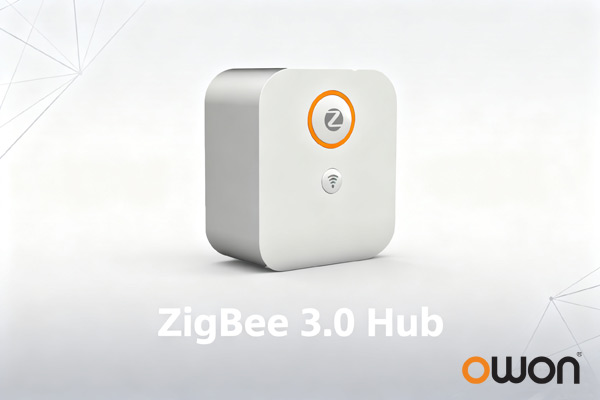The global commercial ZigBee gateway market is projected to reach $4.8 billion by 2030, with ZigBee 3.0 hubs emerging as the backbone of scalable IoT systems for hotels, factories, and commercial buildings (MarketsandMarkets, 2024). For system integrators, distributors, and facility managers, choosing the right ZigBee 3.0 hub isn’t just about connectivity—it’s about reducing deployment time, cutting maintenance costs, and ensuring compatibility with hundreds of devices. This guide breaks down how OWON’s SEG-X3 and SEG-X5 ZigBee 3.0 hubs address B2B pain points, with real-world use cases and technical insights to inform your procurement decision.
Why B2B Teams Prioritize ZigBee 3.0 Hubs (And What They’re Missing)
- Scalability: Consumer hubs top out at 30 devices; commercial hubs need to support 50+ (or 100+) devices without lag.
- Reliability: Downtime in a hotel’s room control system or a factory’s sensor network costs $1,200–$3,500 per hour (Statista, 2024)—commercial hubs require redundant connections (Ethernet/Wi-Fi) and local control backups.
- Integration Flexibility: B2B teams need open APIs to connect hubs to existing BMS (Building Management Systems) or custom dashboards—not just a consumer mobile app.
OWON SEG-X3 vs. SEG-X5: Choosing the Right ZigBee 3.0 Hub for Your B2B Project
1. OWON SEG-X3: Flexible ZigBee 3.0 Hub for Small-to-Medium Commercial Spaces
- Dual Connectivity: Wi-Fi + ZigBee 3.0 (2.4GHz IEEE 802.15.4) for easy integration into existing wireless networks—no need for extra Ethernet wiring.
- Compact & Deployable Anywhere: 56x66x36mm size, direct plug-in design (US/EU/UK/AU plugs included), and 30m indoor range—ideal for mounting in hotel closets or office utility rooms.
- Open APIs for Integration: Supports Server API and Gateway API (JSON format) to connect to third-party BMS platforms (e.g., Siemens Desigo) or custom mobile apps—critical for system integrators.
- Low Power, High Efficiency: 1W rated power consumption—cuts long-term energy costs for multi-hub deployments.
2. OWON SEG-X5: Enterprise-Grade ZigBee 3.0 Hub for Large-Scale B2B Deployments
- Ethernet + ZigBee 3.0: 10/100M Ethernet port ensures stable, low-latency connections for mission-critical systems (e.g., factory equipment monitoring), plus ZigBee 3.0 support for 128 devices (with 16+ ZigBee repeaters)—a 4x increase over consumer hubs.
- Local Control & Backup: Linux-based OpenWrt system enables “offline mode”—if cloud connectivity drops, the hub still manages device linkage (e.g., “motion detected → turn on lights”) to avoid operational downtime.
- Device Sync & Replacement: Built-in backup/transfer 功能 —replace a faulty hub in 5 steps, and all sub-devices (sensors, switches), schedules, and scenes auto-sync to the new unit. This cuts maintenance time by 70% for large deployments (OWON customer data, 2024).
- Enhanced Security: SSL encryption for cloud communication, ECC (Elliptic Curve Cryptography) for ZigBee data, and password-protected app access—meets GDPR and CCPA compliance for customer data (critical for hotels and retail).
Critical Technical Considerations for B2B ZigBee 3.0 Hub Selection
1. ZigBee 3.0 Compliance: Non-Negotiable for Compatibility
2. Mesh Networking: The Key to Large-Scale Coverage
- A 10-floor office building with one SEG-X5 on each floor can cover 100% of the space using PIR313 sensors as repeaters.
- A factory with thick walls can use OWON’s CB 432 smart relays as Mesh nodes to ensure sensor data reaches the hub.
3. API Access: Integrate with Your Existing Systems
- Connect the hub to custom dashboards (e.g., a hotel’s guest room management portal).
- Sync data with third-party platforms (e.g., a utility company’s energy monitoring system).
- Customize device behavior (e.g., “turn off A/C if a window is open” for energy savings).
FAQ: B2B Procurement Questions About ZigBee 3.0 Hubs (Answered for OWON)
Q1: How do I decide between the OWON SEG-X3 and SEG-X5 for my project?
- Choose the SEG-X3 if you’re deploying 50+ devices (no repeaters needed) or need Wi-Fi flexibility (e.g., small hotels, residential buildings).
- Choose the SEG-X5 if you need 128+ devices, Ethernet stability (e.g., factories), or offline control (e.g., critical industrial systems).
OWON offers free sample testing to help you validate performance in your specific environment.
Q2: Do OWON’s ZigBee 3.0 hubs work with third-party devices ?
Q3: Can I customize the hub for my brand (OEM/ODM)?
- Custom branding (logo on the device and app).
- Tailored firmware (e.g., pre-configured schedules for hotel chains).
- Bulk packaging for distributors.
Minimum order quantities (MOQs) start at 300 units—ideal for wholesalers and equipment manufacturers.
Q4: How secure are OWON’s ZigBee 3.0 hubs for sensitive data (e.g., hotel guest information)?
- ZigBee layer: Preconfigured Link Key, CBKE (Certificate-Based Key Exchange), and ECC encryption.
- Cloud layer: SSL encryption for data transmission.
- Access control: Password-protected apps and role-based permissions (e.g., “maintenance staff can’t edit guest room settings”).
These features have helped OWON hubs pass GDPR and CCPA audits for hospitality and retail clients.
Q5: What’s the total cost of ownership (TCO) compared to consumer hubs?
- Consumer hubs require replacement every 1–2 years; OWON hubs have a 5-year lifespan.
- Consumer hubs lack APIs, forcing manual management (e.g., reconfiguring 100 devices individually); OWON’s APIs cut maintenance time by 60%.
A 2024 OWON customer study found that using the SEG-X5 instead of consumer hubs reduced TCO by $12,000 over 3 years for a 150-room hotel.
Next Steps for B2B Procurement: Get Started with OWON
- Assess Your Needs: Use our free [Commercial ZigBee Hub Selection Tool](link to your resource) to determine if the SEG-X3 or SEG-X5 is right for your project size and industry.
- Request Samples: Order 5–10 sample hubs (SEG-X3/SEG-X5) to test compatibility with your existing devices (e.g., sensors, BMS platforms). OWON covers shipping for qualified B2B buyers.
- Discuss OEM/Wholesale Options: Contact our B2B team to explore custom branding, bulk pricing, or API integration support. We offer flexible terms for distributors and long-term partners.
Post time: Oct-05-2025
